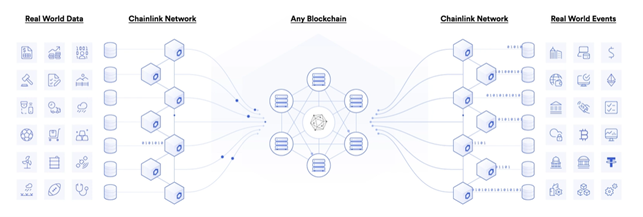
Chainlink launched in 2019 as the first to market a decentralized oracle network. Since then, it has become the de-facto standard in how DeFi & smart contracts interact with the real world. By building a framework for decentralized oracle networks, Chainlink empowers hybrid smart contracts for expansive use by providing a secure foundation for connecting oracle data with real-world, off-chain computation. Contracts rely on external information for fulfilling term agreements. Online, Chainlink can automate that process and remove third-party arbitrators by utilizing blockchain oracles.
By employing a data feed, oracles enable the validation of ongoing terms for related parties while contract stipulations are still being met. This allows all parties to know in real-time where the contract stands without any interruptions/interferences.
Chainlink oracles gather and collect external, real-world data and interact with blockchains to comb through relevant information to feed smart contracts for predictive modeling. In this way, Chainlink compiles and validates data for advanced smart contracts in an automated and efficient way. To showcase its development, Chainlink has been experimenting with real-world use cases, such as bonds. Bonds are fixed-income instruments that represent a loan made by an investor to a borrower (typically corporate or governmental). Chainlink can replicate bond transactions as automated smart contracts by providing the external data required for loan settlement, such as interest rates, debt ratings, and fiat payments.


